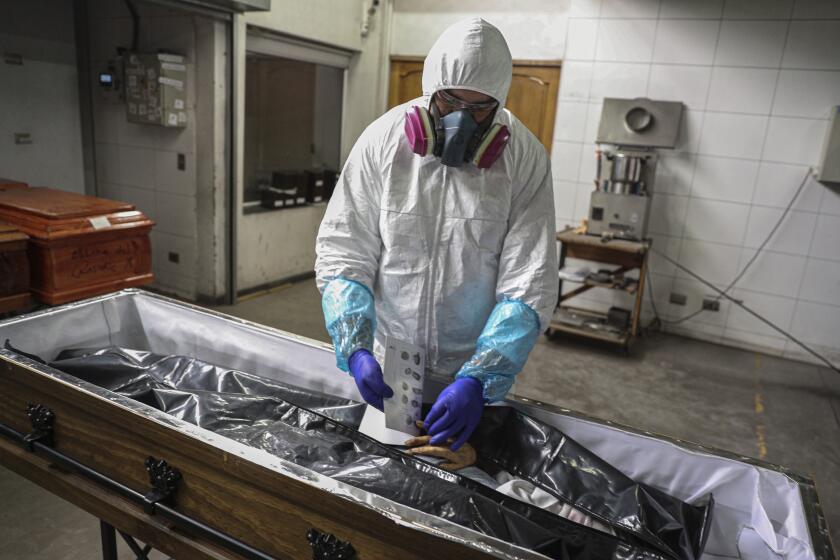Study Sees Wider Use for Heart Implant
Implantable devices that shock a faltering heart back into proper rhythm could potentially save 24,000 lives per year by preventing repeated heart attacks, according to a major new study.
But the devices, similar to the one used by Vice President Dick Cheney, come at considerable cost--as much as $60,000 each, including the cost of implant surgery. They could add more than $1 billion to the national health care bill if they were used by all patients who would benefit.
The devices, called implantable cardioverter defibrillators, or ICDs, already have proved valuable in treating patients who have abnormal heart rhythms, the problem Cheney suffers from.
The new study broadens their application to a much larger group. The devices could be used in 200,000 to 400,000 new patients every year. There is also a backlog of existing heart attack patients--perhaps as many as 2 million--who could also benefit from the devices. The study indicates they would reduce heart attack death rates among all such patients by nearly one third.
“This is an important and major contribution to the field, as it sets new standards for therapy to save lives and improve survival,” said Dr. Arthur J. Moss of the University of Rochester Medical Center, who led the study. “It’s like having your own personal coronary care unit.”
The primary drawback is the expense. The devices cost about $20,000 each, and the surgery can be double or even triple that figure. Fearing the cost, some critics are resisting widespread use.
“It’s too soon to make sweeping recommendations without considering the increased costs,” said Dr. David Faxon, president of the American Heart Assn. “The next step is to narrow in on the type of patient who would benefit most, maximizing the benefits while keeping costs low.”
Moss’ team acknowledged that the cost to implant the devices in all eligible patients “would be substantial.”
“We hope that market forces will drive down the cost of this therapy,” they said in presenting the results.
Moss presented the results Tuesday at an Atlanta meeting of the American College of Cardiology. The report also will be published in Thursday’s New England Journal of Medicine, but the journal is making the paper immediately available online at https://www.nejm.org.
Moss and his colleagues studied 1,232 patients who had suffered a heart attack, whose hearts were working at less than half the normal rate. Heart functioning was determined by the ejection fraction--a measure of how much blood the heart pumps with each contraction. Normal is about 60% or higher; the patients studied had ejection fractions of 30% or lower.
People who have such low ejection fractions have generally had several heart attacks, Moss said, and often have other complicating factors, such as diabetes.
Previous studies have shown that patients with ejection fractions of 30% or lower--about one-quarter of all heart attack victims--have an increased risk of sudden heart attacks caused by abnormal electrical stimulation of the heart. ICDs monitor those electrical impulses and shock the heart when necessary to restore normal rhythms.
All 1,232 patients received conventional drug therapy for their condition; 742 also received an implantable defibrillator.
After an average of 20 months, 19.8% of those receiving only medical therapy had died, compared to 14.2% of those with defibrillators--a decrease of about 30%. That rate of improvement in survival was the biggest since the introduction of the beta-blocker heart drugs in the 1970s, Moss said.
The results were so good that an independent monitoring agency terminated the study prematurely last Nov. 20.
Researchers had expected that the devices would provide a benefit, but “the very dramatic results were surprising,” said Dr. Noelle Langan of Lenox Hill Hospital in New York City.
Those patients receiving the ICDs did have a somewhat higher rate of new or worsened heart failure. But the researchers could find no evidence that the devices were damaging the heart, Moss said. The cause of the problem is more likely to be that the patients are living longer and therefore have more opportunity to get sick, he said.
Moss said his team is now reexamining the data to determine if there is some way to predict which patients would be most likely to benefit from ICDs, allowing physicians to limit the use of the devices.
The study was sponsored by Guidant Corp. of Indianapolis, which manufactures the device used in the trial. Medtronic Inc. and St. Jude Medical Inc. also sell ICDs.
About 80,000 ICDs were implanted in the United States in 2001.



